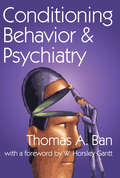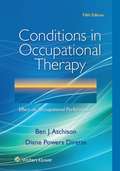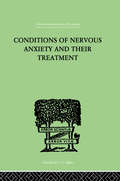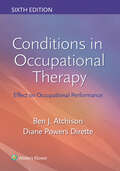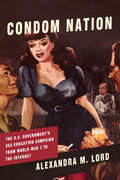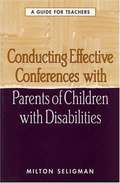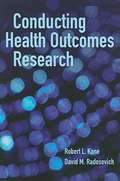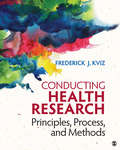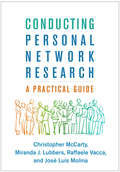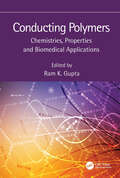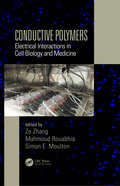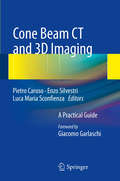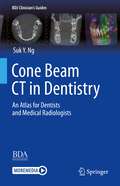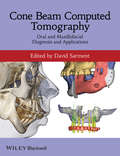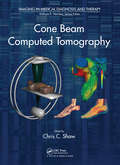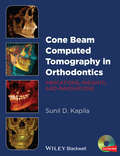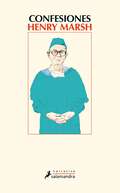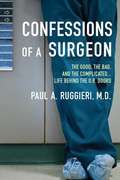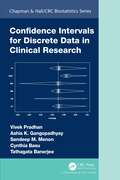- Table View
- List View
Conditioning Behavior and Psychiatry
by Thomas A. Ban W. Horsley GanttConditioning is one of the core methods of psychiatry. It is a behavioral method, with a stimulus-response constellation. The stimulus itself can be measured, changed, and combined, and the responses can be measured qualitatively and quantitatively. Conditioning uses the conditional reflex phenomenon. During the conditioning procedure, responses to certain stimuli are acquired where no responses existed previously. Over time behavioral conditioning expanded to include neurophysiological aspects and has been correlated with psychic manifestations. This comprehensive work deals with the conditioning method, covering fully its behavioral, neurophysiological, and psychiatric aspects.The volume is divided into five parts. Part I summarizes present-day knowledge on the neurophysiology of conditioning. Part II sets out the historical sequence in the correlation between psychopathology and pathological brain functions. Part III describes the best-known conditioning techniques applied in human testing, particularly those which are applicable for diagnostic purposes, is discussed. Part IV is concerned with clinical applications of the method and discusses the findings and the implications that it has for psychopathology and therapy or, in general, for psychiatry. Part V contains a critical evaluation of the matter presented, followed by a bibliography and index."Conditioning Behavior and Psychiatry" describes the development of conditioning procedures since the concept was first introduced. It is primarily concerned with the analysis of elementary and complex behavioral observations, of neurophysiological and neuropathological discoveries as seen from the standpoint of psychiatric disorders. The psychiatric view presented is, not purely the Pavlovian, but a modern approach to psychiatry stemming from a Pavlovian orientation.
Conditions In Occupational Therapy
by Ben Atchison Diane DiretteConditions in Occupational Therapy focuses on chronic health problems and their impact on an individual's physical, cognitive, psychological, and social capabilities. Readers learn how the patient's age, life tasks, and living environment affect occupational therapy needs, and how to determine what occupational therapy services to provide. Chapters present the etiology, symptoms, prognosis, and progression of conditions frequently encountered in practice. Case studies at the end of every chapter help students apply the content to real-life clinical situations. This edition includes new chapters on vision disorders, muscular dystrophy, infectious diseases, and developmental trauma disorder. The expanded art program includes more photos, drawings, charts, and graphs.
Conditions Of Nervous Anxiety And Their Treatment
by Stekel, WFirst published in 1999. Routledge is an imprint of Taylor & Francis, an informa company.
Conditions in Occupational Therapy: Effect on Occupational Performance
by Ben Atchison Diane DiretteLippincott® Connect Featured Title The only text covering the pathophysiology of common diseases specifically relative to Occupational Therapy practice, Conditions in Occupational Therapy: Effect on Occupational Performance, 6th Edition, combines the most up-to-date insights and an engaging approach to ready students for success from the classroom to clinical settings. This updated 6th Edition is fully aligned with the most current DSM-5 and Occupational Therapy Practice Framework, 4th Edition, and adds new chapters reflecting recent advances in the management of infectious diseases, general deconditioning, musculoskeletal pain, amputations, and sickle cell anemia. Each chapter follows a consistent format, presenting an opening case followed by descriptions and definitions, etiology, incidence and prevalence, signs and symptoms, diagnosis, course and prognosis, medical/surgical management, impact on occupational performance, and two case illustrations. Rounded out with robust instructor resources and new full-color imagery, this bestselling resource is an essential tool for today’s occupational therapy and occupational therapy assistant students.
Condom Nation: The U.S. Government's Sex Education Campaign from World War I to the Internet
by Alexandra M. LordAward for the Public Understanding of Science, 2010, British Medical Association's Board of ScienceFirst Prize, Popular Medicine, British Medical Association 2010 Book AwardsThis history of the U.S. Public Health Service's efforts to educate Americans about sex makes clear why federally funded sex education has been haphazard, ad hoc, and often ineffectual.Since launching its first sex ed program during World War I, the Public Health Service has dominated federal sex education efforts. Alexandra M. Lord draws on medical research, news reports, the expansive records of the Public Health Service, and interviews with former surgeons general to examine these efforts, from early initiatives through the administration of George W. Bush. Giving equal voice to many groups in America—middle class, working class, black, white, urban, rural, Christian and non-Christian, scientist and theologian—Lord explores how federal officials struggled to create sex education programs that balanced cultural and public health concerns. She details how the Public Health Service left an indelible mark on federally and privately funded sex education programs through partnerships and initiatives with community organizations, public schools, foundations, corporations, and religious groups. In the process, Lord explains how tensions among these organizations and local, state, and federal officials often exacerbated existing controversies about sexual behavior. She also discusses why the Public Health Service's promotional tactics sometimes inadvertently fueled public fears about the federal government’s goals in promoting, or not promoting, sex education.This thoroughly documented and compelling history of the U.S. Public Health Service's involvement in sex education provides new insights into one of the most contested subjects in America.
Condom Nation: The U.S. Government's Sex Education Campaign from World War I to the Internet
by Alexandra M. LordAn award-winning history of the U.S. Public Health Service’s haphazard efforts to educate Americans about sex for more than a century.Since launching its first sex ed program during World War I, the Public Health Service has dominated federal sex education efforts. Alexandra M. Lord draws on medical research, news reports, the expansive records of the Public Health Service, and interviews with former surgeons general to examine these efforts, from early initiatives through the administration of George W. Bush.Giving equal voice to many groups in America—middle class, working class, black, white, urban, rural, Christian and non-Christian, scientist and theologian—Lord explores how federal officials struggled to create sex education programs that balanced cultural and public health concerns. She details how the Public Health Service left an indelible mark on federally and privately funded sex education programs through partnerships and initiatives with community organizations, public schools, foundations, corporations, and religious groups. With engaging and insightful analysis, Lord explains how tensions among these organizations exacerbated existing controversies about sexual behavior. She also discusses why the Public Health Service’s promotional tactics sometimes fueled public fears about the federal government’s goals in promoting, or not promoting, sex education.Award for the Public Understanding of Science, 2010, British Medical Association’s Board of ScienceFirst Prize, Popular Medicine, British Medical Association 2010 Book Awards
Conducting Effective Conferences with Parents of Children with Disabilities: A Guide for Teachers
by Milton SeligmanThis book provides the knowledge and skills needed to conduct effective conferences with parents of children with disabilities. Readers gain a solid understanding of the challenges that families face as a consequence of childhood disability and the issues that are likely to arise in meetings with school professionals. Reviewing the basic elements of parent-teacher conferencing, Seligman highlights ways to develop strong listening and responding skills, establish rapport, and engage parents who may feel anxious, frustrated, or angry. Also addressed are the requirements of the legally mandated Individualized Educational Program conference. Enhancing the book's utility are sample dialogues, role-play scenarios and exercises, and referral sources and publications suitable for recommendation to parents.
Conducting Health Outcomes Research
by Robert L. Kane David M. RadosevichConducting Health Outcomes Research serves as the definitive guide to successful investigation of health care outcomes and the key resource for ensuring quality care. As consumer, insurer and government demands for quality health care increase, the field of research required to measure such quality stands to grow exponentially. Conducting Health Outcomes Research brings together the practical, actionable information needed to conduct research on health outcomes, with the goal of measuring the quality of the care being delivered. The book details the methodology for performing successful research in this growing field: from formulating models, choosing study design, measuring and gathering data to assessing and presenting results. The text dually covers risk adjustment and the interplay of demographic, psychological and social factors. Conducting Health Outcomes Research answers the growing call for evidence-based practice, comparative effectiveness reviews and overall quality assurance in health care.
Conducting Health Research: Principles, Process, and Methods
by Frederick J. KvizConducting Health Research: Principles, Process, and Methods presents an integrated and practical introduction to the principles and strategies for planning, implementing, reporting, and assessing health sciences research. Comprehensive in its breadth and depth, with an accessible writing style, this text prepares students in public health and related fields to be adept researchers and consumers of health research. Through real-world examples and step-by-step guidance, Frederick J. Kviz provides students with the skills they need to: identify and evaluate research strengths and limitations as practitioners; to actually perform the various core aspects of research; and to choose among alternative methods when making decisions about health practice, policy, and future research needs.
Conducting Health Research: Principles, Process, and Methods
by Frederick J. KvizConducting Health Research: Principles, Process, and Methods presents an integrated and practical introduction to the principles and strategies for planning, implementing, reporting, and assessing health sciences research. Comprehensive in its breadth and depth, with an accessible writing style, this text prepares students in public health and related fields to be adept researchers and consumers of health research. Through real-world examples and step-by-step guidance, Frederick J. Kviz provides students with the skills they need to: identify and evaluate research strengths and limitations as practitioners; to actually perform the various core aspects of research; and to choose among alternative methods when making decisions about health practice, policy, and future research needs.
Conducting Personal Network Research: A Practical Guide (Methodology in the Social Sciences)
by Christopher McCarty Miranda J. Lubbers Raffaele Vacca José Luis MolinaWritten at an introductory level, and featuring engaging case examples, this book reviews the theory and practice of personal and egocentric network research. This approach offers powerful tools for capturing the impact of overlapping, changing social relationships and contexts on individuals' attitudes and behavior. The authors provide solid guidance on the formulation of research questions; research design; data collection, including decisions about survey modes and sampling frames; the measurement of network composition and structure, including the use of name generators; and statistical modeling, from basic regression techniques to more advanced multilevel and dynamic models. Ethical issues in personal network research are addressed. User-friendly features include boxes on major published studies, end-of-chapter suggestions for further reading, and an appendix describing the main software programs used in the field.
Conducting Polymers: Chemistries, Properties and Biomedical Applications
by Ram K. GuptaConducting polymers are versatile materials that possess both the unique properties of polymeric materials (elastic behavior, reversible deformation, flexibility, etc.) and the ability to conduct electricity with bulk conductivities comparable to those of metals and semiconductors. Conducting Polymers: Chemistries, Properties and Biomedical Applications provides current, state-of-the-art knowledge of conducting polymers and their composites for biomedical applications. This book covers the fundamentals of conducting polymers, strategies to modify the structure of conducting polymers to make them biocompatible, and their applications in various biomedical areas such as drug/gene delivery, tissue engineering, antimicrobial activities, biosensors, etc. FEATURES Covers the state-of-the-art progress on biodegradable conducting polymers for biomedical applications Presents synthesis, characterization, and applications of conducting polymers for various biomedical research Provides the fundamentals of biodegradation mechanisms and the role of conduction in biomedical devices Offers details of novel methods and advanced technologies used in biomedical applications using conducting polymers Highlights new directions for scientists, researchers, and students to better understand the chemistry, technologies, and applications of conducting polymers This book is essential reading for all academic and industrial researchers working in the fields of materials science, polymers, nanotechnology, and biomedical technology.
Conducting an Observational Epidemiological Study: From Idea to Publication
by Sarah CuschieriThis concise, user-friendly book provides an accessible guide for anyone wishing to pursue an epidemiological study. It provides the essential tools to understand what epidemiology is, how to choose the correct observational study design for a research question, and how to collect or access data to conduct the study.The book begins by considering, in light of the COVID-19 pandemic, the importance of epidemiological studies, as well as highlighting key issues such as bias, causality, and ethics. There are then chapters on the different types of observational epidemiological studies, including case studies, ecological and mixed methods, and the data sources available to researchers.Following this, and central to the book, is a step-by-step case study on how to conduct a cross-sectional project. Concluding by guiding readers from conducting the research to publishing its findings, this is the ideal companion for students, researchers, or healthcare professionals approaching epidemiological research for the first time.
Conductive Polymers: Electrical Interactions in Cell Biology and Medicine (Series in Materials Science and Engineering)
by Ze Zhang Mahmoud Rouabhia Simon E. MoultonThis book is dedicated to the field of conductive polymers, focusing on electrical interactions with biological systems. It addresses the use of conductive polymers as the conducting interface for electrical communications with the biological system, both in vitro and in vivo. It provides an overview on the chemistry and physics of conductive polymers, their useful characteristics as well as limitations, and technologies that apply conductive polymers for medical purposes. This groundbreaking resource addresses cytotoxicity and tissue compatibility of conductive polymers, the basics on electromagnetic fields, and commonly used experimental methods. Readers will also learn how cells are cultured in vitro with conductive polymers, and how conductive polymers and living tissues interact electrically. Throughout the contents, chapter authors emphasize the importance of conductive polymers in biomedical engineering and their potential applications in medicine.
Cone Beam CT and 3D imaging: A Practical Guide
by Enzo Silvestri Luca Maria Sconfienza Pietro CarusoCone beam computed tomography (CBCT) has become the standard of reference in dental imaging. The distribution of CBCT devices is increasingly wide, and the number of required examinations is constantly growing. In this setting, it is now essential that medical and technical staff receive specific training in the use of CBCT and that technical guidelines for CBCT examinations are established. This clearly structured book on CBCT will be an ideal aid in daily clinical practice. It clearly explains basic CBCT anatomy, examination technique, and the use of 3D reformatting software. A wide range of cases are presented, covering the most frequent and relevant conditions and pathologies, including dental anomalies, inflammatory and degenerative disease, tumors, and implants.
Cone Beam CT in Dentistry: An Atlas for Dentists and Medical Radiologists (BDJ Clinician’s Guides)
by Suk Y. NgThis superbly illustrated book gives a comprehensive introduction to CBCT and its use for diagnosis of dental conditions and treatment planning in the dental practice. After an introductory chapter on the basics of CBCT scans, detailed description is provided on dental anatomic structures and their appearance on CBCT. Various common dental diseases are shown and discussed, as well as signs of malignancy. The book will arm the reader with fundamental knowledge of the radiological appearance of dento-alveolar anatomy and provide guidance on the interpretation of artefacts, disease and some well-known anatomical variations. While it is intended primarily for dentists, this book will be of high value for multiple other health care professionals including medical radiologists.Videos via app: download the SN More Media app for free, scan a link with play button and access videos directly on your smartphone or tablet.
Cone Beam Computed Tomography
by David SarmentWritten for the clinician, Cone Beam Computed Tomography helps the reader understand how CBCT machines operate, perform advanced diagnosis using CT data, have a working knowledge of CBCT-related treatment planning for specific clinical tasks, and integrate these new technologies in daily practice.This comprehensive text lays the foundation of CBCT technologies, explains how to interpret the data, recognize main pathologies, and utilize CBCT for diagnosis, treatment planning, and execution. Dr. Sarment first addresses technology and principles, radiobiologic risks, and CBCT for head and neck anatomy. The bulk of the text discusses diagnosis of pathologies and uses of CBCT technology in maxillofacial surgical planning, orthodontic and orthognathic planning, implant surgical site preparation, CAD/CAM surgical guidance, surgical navigation, endodontics airway measurements, and periodontal disease.
Cone Beam Computed Tomography (Imaging in Medical Diagnosis and Therapy)
by Chris C. ShawConventional computed tomography (CT) techniques employ a narrow array of x-ray detectors and a fan-shaped x-ray beam to rotate around the patient to produce images of thin sections of the patient. Large sections of the body are covered by moving the patient into the rotating x-ray detector and x-ray source gantry. Cone beam CT is an alternative te
Cone Beam Computed Tomography in Orthodontics
by Sunil Kapilain Orthodontics is organized to progress sequentially through specific topics so as to build the knowledgebase logically in this important and rapidly evolving field. Part I provides the foundational information on CBCT technology, including radiation exposure and risks, and future evolutions in computed tomography. Part II presents the Principles and Protocols for CBCT Imaging in Orthodontics, focusing on developing evidence-based criteria for CBCT imaging, the medico-legal implications of CBCT to the professional and the protocols and integration of this technology in orthodontic practice. Part III provides critical information on CBCT-based Diagnosis and Treatment Planning that includes how to interpret CBCT scans, identify incidental pathologies and the possible other uses of this technology. Part IV covers practical aspects of CBCT's Clinical Applications and Treatment Outcomes that encompasses a range of topics, including root morphology and position, treatment of impacted teeth, virtual surgical treatment planning and outcomes, and more.
Conexiones: Una historia de las emociones
by Karl DeisserothUn relato elegante y empático que rastrea los orígenes de nuestras emociones a partir de fascinantes historias clínicas. Karl Deisseroth ha dedicado su vida a la comprensión de la mente y es uno de los pocos neurólogos que además son psiquiatras con consulta en activo. Esa combinación da lugar a un enfoque extremadamente original que busca la base biológica de las enfermedades mentales. A partir de una investigación puntera y de la experiencia con sus propios pacientes, narra, con una profunda empatía, la gran historia de los orígenes de las emociones humanas. Así, el caso de una joven con un trastorno de alimentación explica cómo la mente puede rebelarse contra impulsos tan primitivos como el hambre y la sed; el de un hombre mayor, ahogado por la depresión y la demencia, muestra cómo los seres humanos evolucionaron para sentir no solo la alegría, sino también su ausencia; y el de una solitaria mujer uigur, alejada de su tierra natal, revela la importancia y los desafíos de los vínculos sociales. Una obra que transforma lo que sabemos sobre nosotros mismos e ilustra de forma vívida, a través de las historias humanas, siempre imprescindibles, nuestra búsqueda de conexión y sentido. La crítica ha dicho:«Recuerda a los casos de Oliver Sacks y a la amplia mirada de Sapiens. Escribe con verdadero amor por las palabras, pero también con una lúcida línea de investigación científica».The Guardian «Un análisis brillante y conmovedor del cerebro humano y las emociones. Una gran lectura».Nature «Logra la difícil hazaña de conmover e iluminar al lector al mismo tiempo. Un libro hermoso de leer y repleto de ciencia de vanguardia».The Observer «Un psiquiatra perspicaz y un escritor fascinante que conecta maravillosamente los sentimientos internos de todos los seres humanos con los profundos conocimientos de la psiquiatría y la neurociencia modernas».Robert Lefkowitz, premio Nobel «Deisseroth escribe sobre casos clínicos desgarradores y desesperados con los conocimientos de un médico y la habilidad narrativa de un novelista. Me fascinó; no pude dejar de leerlo».May-Britt Moser, premio Nobel «Un escritor impresionante. Este libro es un tour de force».Abraham Verghese, autor de Hijos del ancho mundo «Poético, hace volar la mente y es profundamente humano de principio a fin».Daniel Levitin, autor de El cerebro musical
Confesiones
by Henry MarshEl eminente cirujano británico Henry Marsh comparte en este libro vivencias de su etapa de estudiante, de los casos más impactantes de sus primeros años y nos invita a reflexionar sobre lo que de verdad importa y el sentido de la vida. Un libro imprescindible. Con la publicación de Ante todo no hagas daño, el brillante neurocirujano conmovió a lectores de todo el mundo al relatar en primera persona su dilatada experiencia clínica en una de las especialidades menos conocidas de la práctica médica. En un inusitado gesto de valentía y honestidad intelectual, reveló sin ambages las dos caras de una profesión que suscita un abanico de emociones intensas, desde momentos de máxima exaltación hasta fracasos devastadores. En este libro, tan apasionante como el anterior, el doctor Marsh, retirado ya tras haber ejercido durante más de tres décadas en un hospital público de Londres, comparte vivencias de su etapa de estudiante, de los casos más impactantes de sus primeros años y también de su labor altruista en Nepal y Ucrania, llevada a cabo en unas condiciones especialmente precarias. Marsh desgrana un episodio tras otro, pintando un fresco memorable de un oficio colmado de incertidumbres y en el que, a menudo, el empeño por prolongar la vida al precio que sea implica un sufrimiento innecesario para los pacientes y sus familias. Así pues, la voz íntima y generosa de Henry Marsh compone un ideario humanista que nos aporta nuevas razones para dotar de sentido a la existencia. Su visión de la realidad, rigurosa pero afable, es un bálsamo en un ámbito, el de la medicina y la sanidad, cada día más impersonal e hipertecnificado. Reseñas:«Soberbio. [...] No quería que este libro se acabase. [...] Sus frases se nos antojan obra de la más delicada ejecución, realizadas con el mismo amor que Marsh destina a la carpintería y la cirugía.»The Daily Telegraph «Sensacional. [...] Nos encontramos con un Marsh cascarrabias, atrevido, flemático, competitivo, en ocasiones desdeñoso e invariablemente guiado por la curiosidad.»The Sunday Times «Marsh se ha jubilado, y eso significa que ha iniciado un inventario exhaustivo de su vida. Las reflexiones y recuerdos del autor hacen que Confesiones sea un libro más introspectivo, si cabe, que el anterior.»The New York Times «Un libro muy entretenido. [...] Abunda en él la honestidad, una cualidad tan rara y admirable entre los cirujanos de élite como, supongo, entre los escritores de libros de memorias.»The Guardian
Confessions of a Sin Eater: A Doctor's Reflections
by Therese ZinkDr. Therese Zink, teacher, clinician and researcher, explores the burden, mystery and privilege of doctoring. As a family physician, the act of listening and holding stories is a vital part of healing for both the patients and the healer. In this collection, Dr. Zink shares stories she gathered while caring for patients in a domestic violence shelter, on the Navajo reservation, in Nazran, Ingushetia (Russia), on mission trips in Latin America and in her clinic in rural Minnesota. Confessions of a Sin Eater lays bare the human heart of the author and reveals the best and worst of our journeys as humans. Discussion questions are included.
Confessions of a Surgeon
by Paul A. RuggieriAs an active surgeon and former department chairman, Dr. Paul A. Ruggieri has seen the good, the bad, and the ugly of his profession. In Confessions of a Surgeon, he pushes open the doors of the O.R. and reveals the inscrutable place where lives are improved, saved, and sometimes lost. He shares the successes, failures, remarkable advances, and camaraderie that make it exciting. He uncovers the truth about the abusive, exhaustive training and the arduous devotion of his old-school education. He explores the twenty-four-hour challenges that come from patients and their loved ones; the ethics of saving the lives of repugnant criminals; the hot-button issues of healthcare, lawsuits, and reimbursements; and the true cost of running a private practice. And he explains the influence of the "white coat code of silence" and why patients may never know what really transpires during surgery.Ultimately, Dr. Ruggieri lays bare an occupation that to most is as mysterious and unfamiliar as it is misunderstood. His account is passionate, illuminating, and often shocking-an eye-opening, never- before-seen look at real life, and death, in the O.R.
Confessions of an Air Ambulance Doctor
by Dr Tony BleetmanNote to customers: This book is also available under the title "You Can't Park There!: The Highs and Lows of an Air Ambulance Doctor". 'People get into this work for "the juice", meaning the adrenaline rush, but they don't tell you about the other juices - the mud, blood, snot and grot.' Confessions of an Air Ambulance Doctor is the first ever behind-the-scenes account of life onboard an air ambulance. The first of its kind to carry doctors and surgeons who can take the hospital to the patient. Drug addicts, lorry crashes, open-heart surgery, stab wounds, headless chickens, mating llamas, and strip routines – it’s all in a day’s work for emergency doctor Tony Bleetman and his team. Whether they are landing in the middle of the M1 or at a maximum security jail, Tony and his crew Helimed 999 are the first on the scene in the most critical of emergencies. This gripping read will make you laugh, cry and marvel at the wonders of life (and death) in equal measure.
Confidence Intervals for Discrete Data in Clinical Research (Chapman & Hall/CRC Biostatistics Series)
by Sandeep M. Menon Vivek Pradhan Ashis Gangopadhyay Cynthia Basu Tathagata BanerjeeConfidence Intervals for Discrete Data in Clinical Research is designed as a toolbox for biomedical researchers. Analysis of discrete data is one of the most used yet vexing areas in clinical research. The array of methodologies available in the literature to address the inferential questions for binomial and multinomial data can be a double-edged sword. On the one hand, these methods open a rich avenue of exploration of data; on the other, the wide-ranging and competing methodologies potentially lead to conflicting inferences, adding to researchers' confusion and frustration and also leading to reporting bias. This book addresses the problems that many practitioners experience in choosing and implementing fit for purpose data analysis methods to answer critical inferential questions for binomial and count data. The book is an outgrowth of the authors' collective experience in biomedical research and provides an excellent overview of inferential questions of interest for binomial proportions and rates based on count data, and reviews various solutions to these problems available in the literature. Each chapter discusses the strengths and weaknesses of the methods and suggests practical recommendations. The book's primary focus is on applications in clinical research, and the goal is to provide direct benefit to the users involved in the biomedical field.
